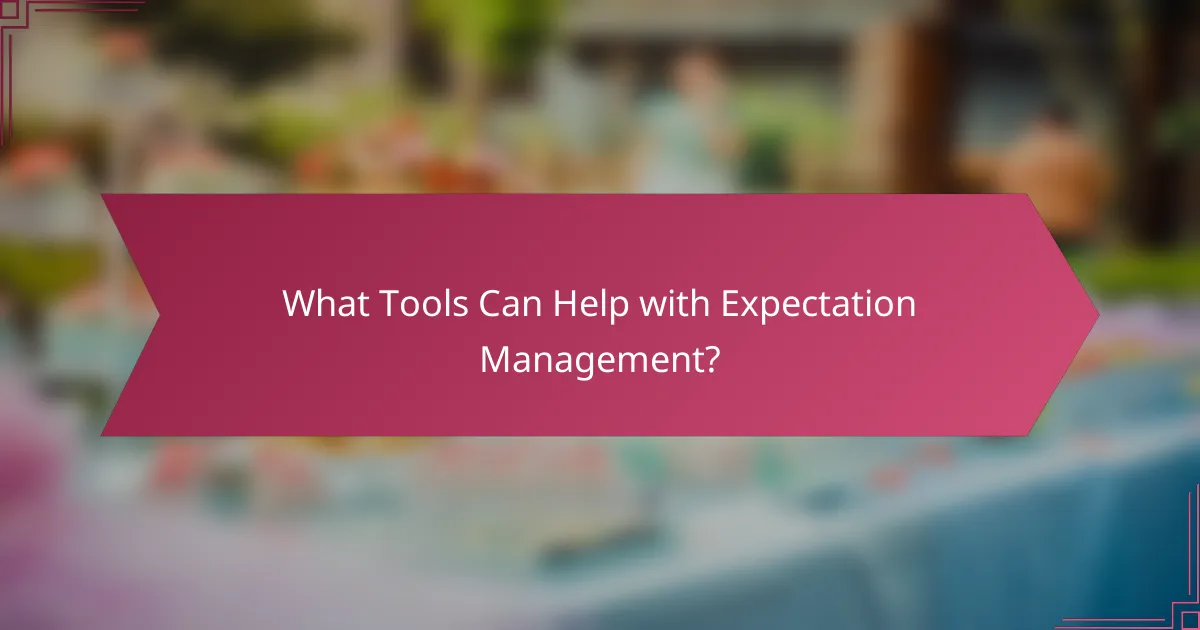Managing expectations is essential for successful client relationships, requiring clear communication, realistic timelines, and ongoing transparency. By fostering trust through open dialogue and sharing vital information about processes and potential challenges, you can align project goals and reduce uncertainty for all stakeholders involved.

How to Manage Client Expectations Effectively?
Managing client expectations effectively involves clear communication, realistic timelines, and ongoing transparency. By establishing these elements, you can foster trust and ensure that clients are aligned with project goals and progress.
Set clear communication channels
Establishing clear communication channels is essential for managing client expectations. Decide on the primary methods of communication, such as email, phone calls, or project management platforms, and ensure both parties are comfortable using them.
Regularly scheduled check-ins can help maintain open lines of communication. This could be a weekly call or a daily update message, depending on the project’s complexity and urgency.
Establish realistic timelines
Realistic timelines are crucial for setting client expectations. Assess the project’s scope and complexity, and provide a timeline that reflects achievable milestones rather than overly optimistic deadlines.
Consider using a timeline that includes buffer periods for unexpected delays. For example, if a task typically takes two weeks, suggest a timeline of three weeks to account for potential setbacks.
Provide regular updates
Regular updates keep clients informed and engaged throughout the project. Schedule updates at consistent intervals, such as bi-weekly or monthly, to share progress, challenges, and any adjustments to the timeline.
Utilize visual aids, like progress charts or dashboards, to make updates more digestible. This can help clients visualize where the project stands and what remains to be done.
Encourage feedback
Encouraging feedback is vital for managing expectations and improving collaboration. Create an environment where clients feel comfortable sharing their thoughts and concerns at any stage of the project.
Consider implementing feedback loops, such as surveys or follow-up meetings, to gather insights. This can help you adjust your approach based on client needs and enhance overall satisfaction.
Utilize project management tools
Project management tools can streamline communication and enhance transparency. Platforms like Trello, Asana, or Monday.com allow you to track tasks, deadlines, and progress in real time.
Choose a tool that fits your team’s workflow and your client’s preferences. Providing clients access to these tools can empower them to monitor progress and stay informed, which helps manage their expectations effectively.

What Role Does Transparency Play in Managing Expectations?
Transparency is crucial in managing expectations as it fosters open communication and builds trust between parties. By clearly sharing information about processes, timelines, and potential challenges, stakeholders can align their goals and reduce uncertainty.
Build trust with clients
Building trust with clients starts with honest communication. When clients are informed about project developments, potential delays, or changes in scope, they feel valued and respected. This trust can lead to stronger long-term relationships and increased client loyalty.
To enhance trust, consider regular updates through emails or meetings. Providing a clear timeline and sticking to it, while promptly addressing any issues, reinforces your commitment to transparency.
Enhance decision-making
Transparency enhances decision-making by providing all relevant information needed for informed choices. When clients understand the factors influencing a project, they can make better decisions regarding priorities and resource allocation.
Encourage clients to ask questions and express concerns. This two-way communication allows for a more collaborative approach, ensuring that decisions are made based on a comprehensive understanding of the situation.
Reduce misunderstandings
Reducing misunderstandings is essential for smooth project execution. Clear communication about expectations, deliverables, and timelines minimizes the risk of misinterpretation. When everyone is on the same page, projects are more likely to proceed without unnecessary complications.
Utilize tools like shared project management software or detailed project briefs to document agreements and expectations. Regular check-ins can also help clarify any ambiguities before they escalate into larger issues.

What Are the Best Practices for Setting Timelines?
Effective timeline management involves clear planning, realistic expectations, and proactive communication. By following best practices, you can ensure that all stakeholders are aligned and prepared for the project’s progression.
Define project milestones
Project milestones are key points that mark significant stages in a project timeline. Clearly defining these milestones helps in tracking progress and maintaining focus on critical deliverables. For example, a software development project might include milestones such as completion of the design phase, development of the first prototype, and final testing.
When setting milestones, consider using the SMART criteria—Specific, Measurable, Achievable, Relevant, and Time-bound. This approach ensures that each milestone is clear and attainable, which can enhance team motivation and accountability.
Incorporate buffer time
Buffer time is additional time added to a project schedule to accommodate unforeseen delays or challenges. Including buffer time can prevent stress and ensure that deadlines are met without compromising quality. A common practice is to add 10-20% of the total project duration as buffer time, depending on the project’s complexity.
For instance, if a project is expected to take three months, consider planning for an additional two to three weeks as a buffer. This allows for flexibility in case of unexpected issues, such as resource availability or technical challenges.
Communicate potential delays
Proactive communication about potential delays is essential for managing expectations. If you foresee any issues that could impact the timeline, inform all stakeholders as soon as possible. This transparency helps maintain trust and allows for collaborative problem-solving.
Establish regular check-ins or updates to discuss progress and any emerging risks. By keeping everyone informed, you can adjust timelines collectively and ensure that all parties remain aligned on project goals and expectations.

What Tools Can Help with Expectation Management?
Several tools can significantly enhance expectation management by promoting clarity, transparency, and effective timelines. Utilizing project management and communication platforms can streamline workflows and ensure all team members are aligned on goals and deadlines.
Trello for project tracking
Trello is a visual project management tool that helps teams track progress through boards, lists, and cards. Each card can represent a task, allowing users to assign responsibilities, set deadlines, and add comments or attachments for context.
To effectively use Trello, create boards for different projects and establish clear labels for tasks based on priority or status. This visual layout helps everyone see what needs attention and reduces misunderstandings about project timelines.
Slack for communication
Slack is a messaging platform designed for team communication, enabling real-time discussions and file sharing. It allows for organized conversations through channels, direct messages, and threads, which can help clarify expectations and keep everyone informed.
To maximize Slack’s effectiveness, create dedicated channels for specific projects or topics. This organization helps maintain focus and ensures that important updates do not get lost in general chatter. Regularly check in on these channels to stay updated on team progress and address any issues promptly.
Asana for task management
Asana is a task management tool that allows teams to create, assign, and track tasks in a structured manner. Users can set due dates, add subtasks, and monitor progress through various views like lists or timelines, which helps maintain transparency in project timelines.
For effective use of Asana, break down larger projects into smaller, manageable tasks and assign them to team members with clear deadlines. Regularly review task progress in team meetings to ensure alignment and address any potential delays before they escalate.

How to Handle Changes in Project Scope?
Handling changes in project scope requires clear documentation, reassessment of timelines and budgets, and prompt communication with all stakeholders. These steps ensure that everyone is aligned and that the project can adapt effectively to new requirements.
Document change requests
Documenting change requests is crucial for maintaining clarity and accountability. Every request should be recorded with details such as the reason for the change, the impact on the project, and who requested it. This creates a clear trail that can be referenced later.
Use a standardized format for documenting changes, including sections for description, justification, and approval status. This helps streamline the process and ensures consistency across all requests.
Reassess timelines and budgets
Once a change request is approved, it’s essential to reassess the project’s timelines and budgets. Changes in scope often require additional resources or time, which can impact the overall project delivery. A thorough evaluation helps in understanding the new requirements and their implications.
Consider creating a revised project plan that includes updated milestones and budget estimates. It’s also wise to factor in a buffer for unforeseen issues that may arise due to the changes.
Communicate changes promptly
Prompt communication of changes is vital to keep all stakeholders informed and engaged. Share updates through meetings, emails, or project management tools to ensure everyone is on the same page regarding the new scope and its implications.
Establish a regular communication schedule to discuss ongoing changes and their impact on the project. This proactive approach helps to mitigate misunderstandings and fosters a collaborative environment.
